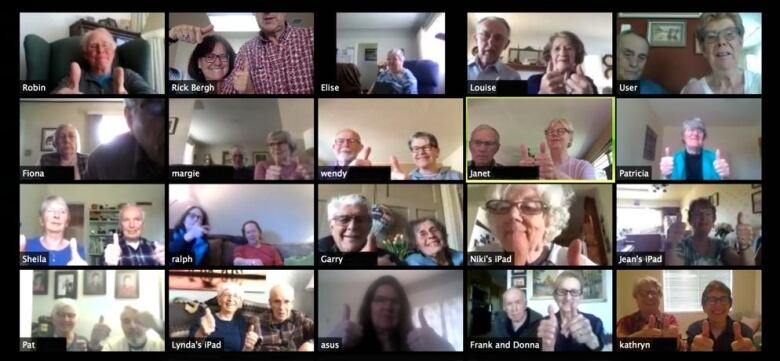This choir for people with dementia was forced apart by the pandemic. Now they're finding new ways to sing
B.C.'s Voices In Motion, a choir for people with dementia, has pivoted to virtual practices

While the sounds of choirs are no longer reverberating in church halls and community centres, Vancouver's Voices in Motion, a choir for people with dementia, is still singing together thanks to technology.
Being unable to meet in person has been a particularly unique challenge for the group, but according to artistic director Erica Phare-Bergh, the choir has risen to the challenge.
"Obviously we can't be together, but we do have our weekly rehearsals still and we bring all the choirs together for that because you can on Zoom," she told The Current's Matt Galloway.
"Here they were learning a new skill," she added, saying that many of the group's members have adapted well to singing into one device while recording themselves with another.
Voices in Motion — an intergenerational group that includes caregivers, family, friends and students — was created in 2017 with a goal to research how singing and music can affect dementia-related biomarkers in the brain.

The members are also part of a research study about whether connecting people of all ages can help create a "dementia-friendly" society.
"It has been erasing some of the silos that we experience intergenerationally," said Phare-Bergh.
Each month during the choir season, choir members and their caregivers are assessed cognitively and physically through tests and surveys.
"Stigma has gone down. Depression has gone down, not just in the person with dementia, but also the caregivers," Phare-Bergh said.
"One student was so moved by her experience of the choir that she's written a book about it and illustrated it."
Viral transmission by singing
Virtual rehearsals are the closest Voices In Motion will get to live performances for now.
For many, social isolation can be hard both mentally and physically, Phare-Bergh says. Being part of the choir helps alleviate that.
"You're creating bonds, you're creating meaning and people are able to contribute," she said.

But coming together any time soon could prove difficult, according to Lucinda Halstead, president of the Performing Arts Medical Association and the medical director for voice and swallowing at the University of South Carolina.
"What we know is that the louder the voice gets, the more [viral] particles are emitted and put into the room," she said.
"We also know that by extrapolation, the loudest voices, which would be singing voices, would produce that much more."
While masks could potentially reduce the spread of large viral particles and droplets, smaller ones can escape, travel further and are the "most likely to be inhaled."
"The safest thing, obviously, [is] being able to test the choir at the time they walk in the door to make sure that they are COVID negative," she said.
Choirs could also come together in smaller groups, spread farther apart. But even then, Halstead says, having proper ventilation is key.
"If you have a choir of 80 people, my recommendations are to do other things that are creative and decrease the overall risk until we get things that will allow you to congregate together," Halstead said.
"I would like that choir of 80 people to be 80 people in two years."
'A long way off for now'
Until then, Phare-Bergh is finding other ways to help the group stay connected, and share each other's stories.
"We're going to be developing a cookbook because we like to eat together. So we're having everybody send in recipes and the story that goes along with it," she said.
Phare-Bergh says that what she most looks forward to when Voices in Motion can once again come together in person are the hugs.
"Physical touch becomes really important," she said. "I know that that's a long way off for now."
Written by Jason Vermes. Produced by Elizabeth Hoath.
